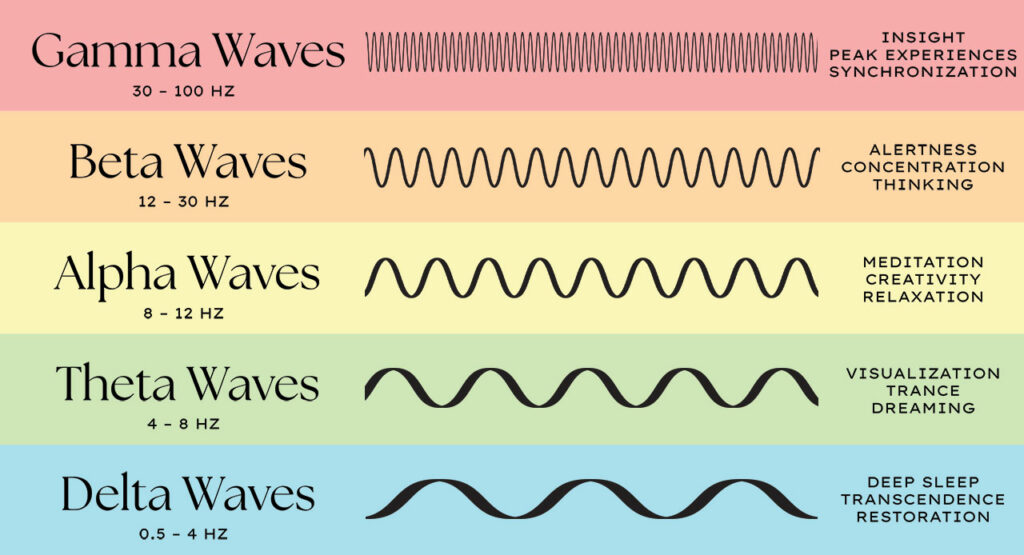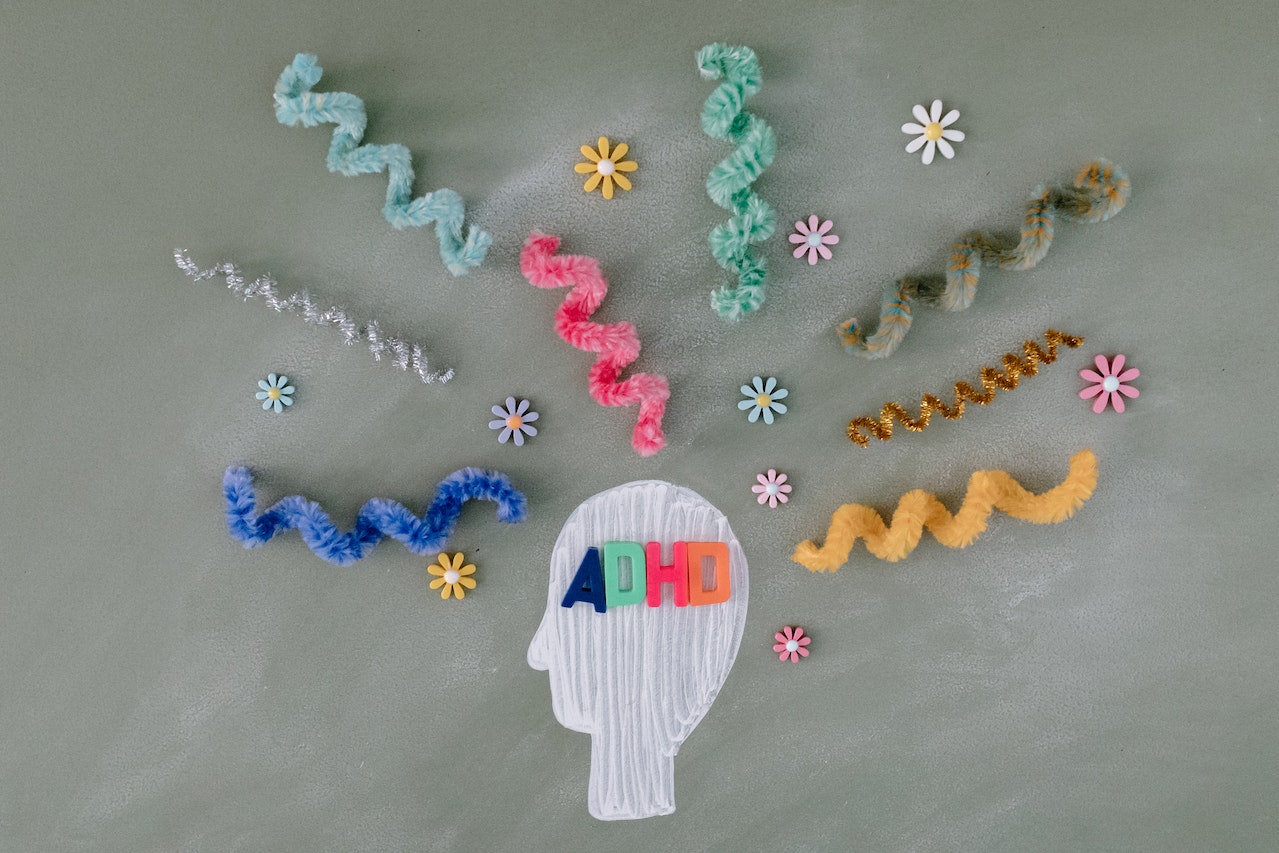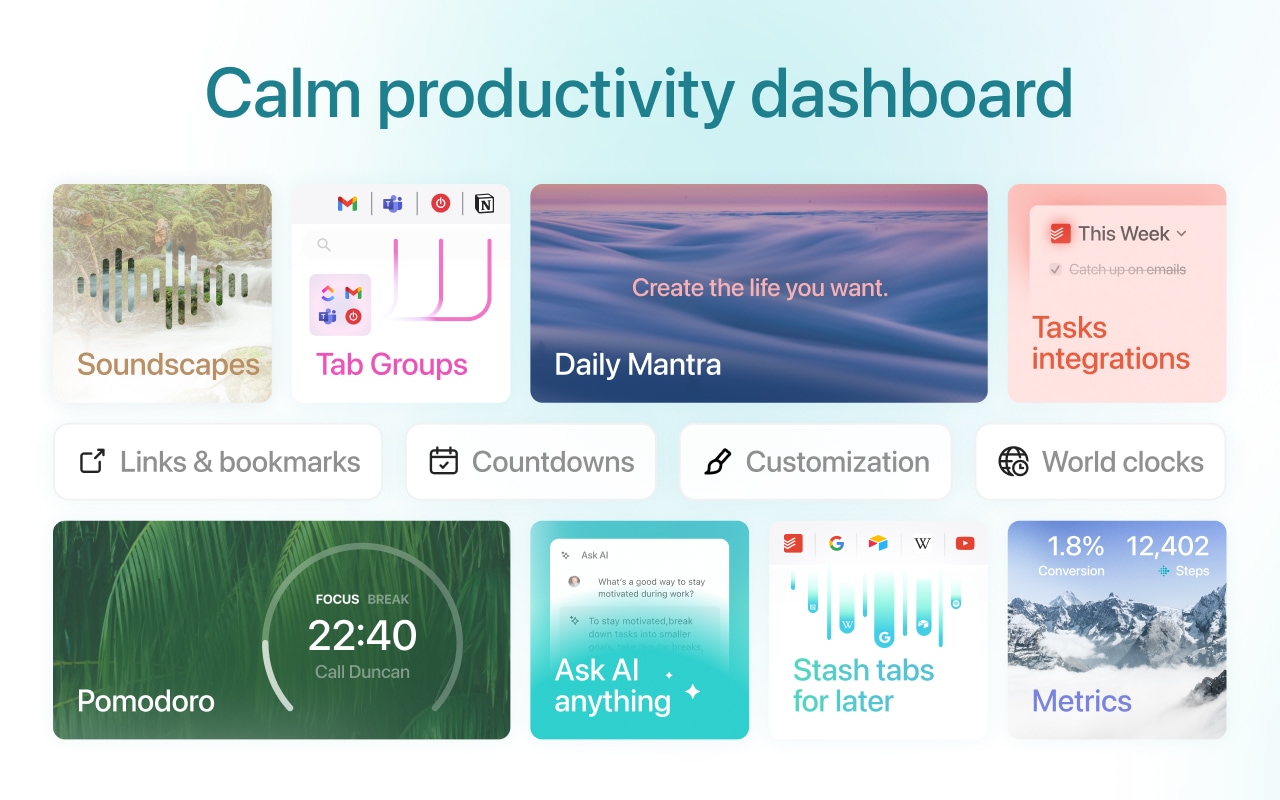One of the best ways to get your ADHD brain to focus is by listening to instrumental music while you are working.
A good instrumental music track that is not predictable helps increase novelty, which can boost your dopamine and make it easier to focus. Generally, I recommend not listening to music with lyrics when you want to get focused.
I’ve spent a lot of time experimenting with instrumental music to help my ADHD brain get more focused and I’ve found that combining instrumental music with binaural beats and isochronic tones takes my ability to focus to the next level.
The brainwave entrainment effect of binaural beats and isochronic tones can be significant for some people while not effective for others. It’s important to actively experiment to see what works best for your unique ADHD brain.
How To Use Binaural Beats And Isochronic Tones For ADHD:
There are 5 different frequencies of brain waves that can be entrained using binaural beats and isochronic tones.

I’ve included details about how each brainwave may be helpful for ADHD as well as some of my favourite ADHD-friendly playlists with a huge variety of free tracks you can listen to experiment for yourself.
Here’s a quick primer on using binaural beats and isochronic tones for improving ADHD focus:
- Choose a binaural beat frequency for the state you desire.
- Find a comfortable place to work free of distractions.
- Always listen to binaural beats with high-quality stereo headphones.
- Experiment with the different frequencies to find what works best for you.
- Do flow sessions of at least 25 minutes to get the full experience.
- Focus on doing a specific activity for the duration of the session.
- After your session, get up and take a short walk to recharge.
Here are some of the best ways to use brainwave entrainment music to get your ADHD brain to focus:
1. Gamma Waves (30 – 100 Hz):
Gamma waves are helpful for those ADHD days when you struggle with task paralysis and procrastination and you need a cognitive boost to get out of a motivational slump.
They are associated with peak levels of concentration levels, new insights and brain synchronization. They are the least understood form of brain waves because they are hard to measure with wearable EEG devices and tend to briefly spike in combination with various other brainwave states.
I recommend only using them for a few hours a day. A good place to start is with 40 Hz gamma waves. Skeptical? Dr. Andrew Huberman has an excellent short talk on the cognitive benefits of 40Hz gamma waves.
2. Beta Waves (12 – 30 Hz)
Beta waves are a higher frequency brainwave associated with our normal waking state when we are actively engaged in thinking or a task. They are great for the basic linear problem solving that is needed for most of our daily tasks.
People with ADHD tend to have lower beta brainwave activity and much higher theta activity so listening to different frequencies of beta waves could be helpful for improving focus and concentration.
Lower beta binaural beats in a brainwave frequency known as SMR Waves (between 12-15 Hz) are often helpful for ADHD. They can help with keeping your attention focused without too much strain.
3. Alpha Waves (8 – 12 Hz)
When you have higher activity of alpha brain waves, your brain becomes relaxed with a focus on enjoying the present moment.
Alpha brain waves are good for creative flow states as well as relaxing and meditating. They can help you when you want to quiet your overactive ADHD brain or do something creative like writing, designing or making a presentation.
I recommend listening to alpha waves around 8-10 Hz after a long day of work when you struggle to stop mindlessly scrolling on your phone as they can help you just relax and do something creative instead.
4. Theta Waves (4 – 8 Hz)
Theta brain waves tend to be much higher in people with ADHD, which results in a dreamlike state of mind wandering along with random insights and connections that make many ADHDers excellent at divergent thinking.
Generally, if you want to focus better at work and get out of a motivational slump then you’re going to want to entrain higher brainwave frequencies like gamma or beta brain waves.
However, theta brainwave states can be helpful for accessing the subconscious mind and the threshold or liminal states of hypnagogia (going into sleep) and hypnopompia (coming out of sleep) for creative problem solving.
5. Delta Waves (0.5 – 4 Hz)
Delta brain waves are associated with deep, dreamless sleep and heartfelt states of meditative compassion and loving kindness meditation from studies of Buddhist monks wired up to EEG machines that track their brain waves in real-time.
Delta brain waves can be helpful for falling asleep and entering states of deep rest and relaxation through Non-Sleep Deep Rest (NSDR) or Yoga Nidra. I also like to do heart-based gratitude and loving kindness exercises while listening to delta waves for deeper release and relaxation.
Given how important high-quality sleep is for having sharp focus and high energy during the day, delta waves can help improve your ADHD focus by making it easier to fall asleep. They can help you go into a deep state of relaxation instead of lying in bed thinking when you have insomnia.
6. 8D Music
I recently discovered the magic of 8D music, which I find very helpful for giving my ADHD brain the extra musical stimulation I sometimes need to get highly focused on an important task that I find boring and tedious.
I’ve been noticing that a lot of binaural beats and isochronic tones creators on YouTube have started using 8D music in the last year or so. The wave-like flow of 8D music can be hypnotic for the ADHD brain, which is great for entering the flow state.
If you’re skeptical about 8D music and other brainwave entrainment music then try it out for yourself or look at the thousands of comments of people with ADHD talking about how much it has helped them with focus.
7. Solfeggio Frequencies
Last but not least, you have solfeggio frequencies, which I love to use to enter states of deep relaxation when I want to unplug from work and analytical thinking after a long day.
If you’ve ever been to a sound bath or experienced sound healing using medicine bowls then you will instantly recognize solfeggio frequencies.
The key to focus with ADHD is having a well-regulated nervous system so listening to these relaxing frequencies can help calm your nervous system and get you out of the fight-flight-and-freeze response when your sympathetic nervous system (the stress response) is on overdrive.
Finding The Right Music Frequency For Your ADHD Brain
For many adults with ADHD discovering binaural beats can be a revelation. They are excellent at giving our ADHD brains the extra stimulation we often need to get out of task paralysis and get things done.
If you want to learn more about brainwave entrainment music, I have covered more in another in-depth post on the science of using focus music for ADHD.
Generally, the brainwave signature of ADHD is excess theta wave activity and lower beta brainwave activity. That’s why SMR waves, mid-beta waves and gamma waves seem to work well for improving ADHD focus so they are a good place to start your experimentation.
It’s also best to experiment with the different frequencies using both binaural beats and isochronic tones to see which may work best for you. Enjoy the extra focus!
- 10 Tips, Tricks And Tools To Overcome ADHD Paralysis - March 19, 2025
- 10 Interesting Facts About Adult ADHD And Mental Health - March 18, 2025
- 15 Ways To Manage ADHD Without Meds By Biohacking Dopamine - February 14, 2025




